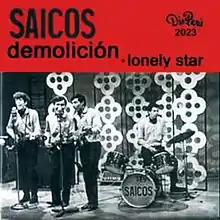| "Demolición" | ||||
|---|---|---|---|---|
 | ||||
| Single by Los Saicos | ||||
| from the album Wild Teen-Punk from Peru 1965 | ||||
| B-side | "Lonely Star" | |||
| Released | May of 1965 [1] | |||
| Recorded | 1964 Lima, Peru | |||
| Genre | ||||
| Length | 2:54 | |||
| Label | Dis-Perú | |||
| Songwriter(s) | Erwin Flores[2] | |||
| Los Saicos singles chronology | ||||
| ||||
| Music video | ||||
| "Demolición'" on YouTube | ||||
Demolición (in English: "Demolition") is a song by the Peruvian rock band Los Saicos.[3] It was the second promotional single and quickly became a success in their country.
Promotion
Released as a single, "Demolition" became one of the most popular songs of Peruvian rock at the time, and it remains so still.[4] The song is an anthem of the group and is among the most beloved in all of Peru. The song is based on a very catchy melody, with disorder and a rhythm very typical of punk music.[2]
Style and composition
The song was composed by the band's vocalist, Erwin Flores, during a rehearsal in 1964. It begins with the hummed cries of Flores: "ta-ta-ta-ta-ta-ta-ta-ta-ya-ya-ya" and its lyrics are anarchic: "Echemos abajo la estación de tren / Echemos abajo la estación de tren / Demoler, Demoler, Demoler / Demoler, demoler la estación de tren" (Let's destroy the train station / Let's destroy the train station / Demolish, demolish, demolish / Demolish, demolish the train station). In spite of the period Peru was going through, the lyrics lack any political content.[5] Its lyrics imply that train stations must be deliberately demolished and destroyed as an act of complete rebellion.[5]
The melody is repetitive and composed of four stanzas. Its harmonic structure comprises three simple major chords: A, D, and E.
The instrumentation is influenced by the surf rock of Dick Dale (which was very popular at the time) and its duration is only 2:53.[5]
In 1965, the song was recorded by the label Dis-Perú in Peru and was published the same year. It was re-released by Electro-Harmonix some years later.[2]
Legacy
See also
References
- ↑ Discogs ~ ¡Demolición! The Complete Recordings liner notes June-2009
- 1 2 3 SAICOS/Demolición.html Manticornio · Rock Progresivo · LOSSAICOS / Demolición Consultado el 14 de julio de 2016
- ↑ "If Peru's Los Saicos Aren't the First Punk Band, They're Pretty Close." Dangerous Minds. Retrieved June 20, 2016
- ↑ Diario El Comercio Perú : En España dicen que el punk nació en el Perú y los precursores fueron Los Saicos Consultado el 14 de julio de 2016
- 1 2 3 Los Saicos, el punk que (dicen) nació en Perú Consultado el 14 de julio de 2016
- ↑ A commercial spot Temptations company is done with the topic "Demolición", song Los Saicos (Spanish) Archived 2016-07-23 at the Wayback Machine Retrieved June 19, 2016